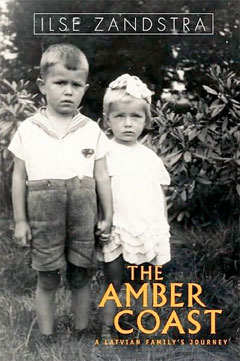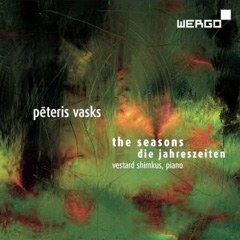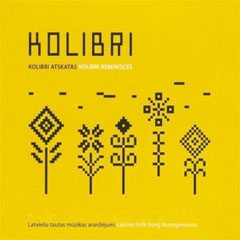
Sometimes the best way to absorb the events and flow of history is through autobiography, especially one that manages succinctness with an elegant style. The Amber Coast: A Latvian Family’s Journey by Ilse Zandstra, née Ilze Zālīte, is captivating at many levels.
The saga of one family’s contented life in Latvia rudely interrupted by the Soviet and Nazi occupations and then ejected like refugee flotsam to many countries is both similar and different from that of several hundred thousand Latvians who fled the Red Army and ended up in the West. The Zālīte family, with two children and carrying only minimal possessions stuffed in a few suitcases, was forced to leave Latvia to avoid a one-way trip to Siberia. They left their prized possession of an Opel Kadett automobile on the docks of Liepāja.
The post-Latvia odyssey was determined in large measure by the nautical engineering profession of Jānis, the sometimes gruff and wilful head of the family. His reputation as a competent and unusually loyal ship specialist became a guarantee of sustenance and survival in chaotic circumstances. The family settled first in Poland, then in Germany, followed by Sweden and finally Montreal, Canada. All these locations provided work in shipyards for Jānis.
The memories of the disruptive changes are recorded from the perspective of a small girl, called Ilzīte by her father, and from her extended interviews of father Jānis, together with information gleaned from letters, documents, clippings, photographs and testimony of a large bevy of relatives.
The major framework of the book and the catalyst for a renewed interest in the history of her family’s wartime and post-war experience was precipitated by a return trip to Latvia in the summer of 1990. Together with her father, Ilse was signed up for a trip on a special chartered Swedish ship, the Baltic Star, also known as “Happy Ship” and the “Baltic Bible Banana Boat.” At that time, Latvia was still a part of the USSR but undergoing profound changes that ultimately led to full independence one year later.
Valuable insights are provided by the initial clash of beliefs, values, ideologies and guilt placement as the Western branch of the family interacts with the relatives “left behind” in Latvia. Misunderstandings and disappointments from both sides reflect the experience of most Western Latvians on their first contact with the homeland.
The author’s keen eye for the subtleties of human interaction and body language provides much material for reflection on what a half century of separate Communist and Western socialization (brainwashing) can accomplish. The trip to Latvia becomes a catalyst for Ilse’s newfound interest in her own background: “My trip to Latvia awakened in me a desire to know more about my past and that of my family.”
Ironically, Ilse, like many immigrant children, had been reluctant to publicize her Latvian heritage, preferring to blend in with the local Swedish and then Canadian culture and language. She even rebelled at her parent’s insistence on using Latvian in conversations with her older brother, Peter. Yet, half a century later, the seeds of Latvian attachment, so adamantly inculcated by her parents on a reluctant soul, finally found a resonance in their daughter. This ancestral echo bloomed and renewed a curiosity about her Latvian roots and the fate of her extended clan both in Latvia and abroad.
Besides the incursions into various episodes of refugee life, tribulations and survival adaptations, the book provides a very detailed portrait of the indomitable patriarch, Jānis Zālīte. He is the type of individual who best represents the protestant work ethic and the Germanic attachment to ordnung. Indeed, his mother was of German origin and taught him this language and culture. His Latvian father, an upwardly mobile teacher, ended up working in Moscow where Jānis was born in 1907.
Throughout life, Jānis abided by the motto of his Latvian fraternity, Tālavija, “darbs ceļ vīru” or “work makes the man.” His type is also the ideal fountainhead of self-reliant entrepreneur who adapts to all curve balls thrown by unusual circumstances. His industriousness was best reflected in a Displaced Persons camp in Oldenburg, Germany, where he decided to start a woodworking shop employing 30 people rather than sitting and waiting for orders from the United Nations Relief and Rehabilitation Administration. The shop successfully created wooden clothes pegs, clogs, toys, benches and large solid suitcases for future expected moves. However, this example of free enterprise did not sit well with the bureaucrats and the shop was forced to close. Fortunately, at that point Janis received an invitation from a Swedish shipyard in Goteborg and the family left this deadend, crowded refugee camp.
There was also the other side to Jānis that permeates many of the conversations between father and daughter, best reflected by the phrase, “Do not interrupt, Daughter!” Indeed, this father-knows-best philosophy was very deeply ingrained in most Latvian families of that vintage. The author summarizes the essence of this cultural thread: “In many ways, my Father was much like his father. Both were strict disciplinarians, and both expected their orders to be obeyed without question. No talking back. No questioning authority.”
The book incorporates many vignettes of Latvian history and culture in a style similar to that of Modris Eksteins in his book, Walking Since Daybreak. Indeed, Ilse claims that she was inspired to write her own story after reading Eksteins book.
The dialogue for the most part is punchy and easy to follow. Stylistically a major contribution is the author’s almost poetic capture of certain emotional events that most Latvians hold dear. For example, her description of the Latvian Song Festival in 1990 on the eve of Latvia’s independence, in an outdoor stadium with over 200,000 attendees and 20,000 singers is a classic of concentrated visions and emotions:
All of a sudden, a loud hum fills the air like a giant swarm of bees as the singers start to limber up their vocal chords. First and second soprano,alto, tenor, and bass, their voices vibrate in an ageless, mystical Ooommm. Folk songs are my homeland’s prayers, its collective memory, its history and lament, even its armour during times of siege or occupation. The refrains can be poignant as the end of summer, or as happy as sunlight dappling white birches. Music is the voice and mood of my people, with one recurring theme, love of their country, and tonight is a night for unrestrained patriotism, for celebration. High up on a specially erected platform and looking no bigger than an insect, a white-gloved conductor stands; with a leap and great sweeping motions of his arms, he starts up the twenty-thousand massed choirs. Sweet notes burst from the singers’ mouths. The conductor sways this way and that, and the music follows him. He spreads his arms wide, and then lifts them, and the melody swells, filling the night with music. The audience is enthusiastic, rivalling the best rock concert crowd. We clap and cheer and shout bravo, over and over.
The book is of obvious interest to all Latvians and a great resource for children and grandchildren of Latvia’s refugees. It is a great source for Latvia’s inhabitants whose knowledge of the exodus of their brethren is woefully inadequate. More importantly, the book has the literary and psychological qualities that can be used as a base of study by all those who want to delve deeper into the psyches of new arrivals in a new land.
One can of course question certain sequence divisions of the book and the purposely stilted phrases attributed to Latvian relatives in the homeland. Another edition of the book should very definitely include an introductory scheme outlining all names and their relationship to the main characters.
The book will suscitate introspection and comparisons for many Latvians abroad. It will bring back memories and may be a catalyst for conversations between generations. In any case, the book is “a good read”” and very entertaining in its own right and should help to provide valuable context to those interested in researching Latvian history, culture and interpersonal relations.
Details
The Amber Coast: A Latvian Family’s Journey
Ilse Zandstra
Tamarac, Fla.: Llumina Press, 2010
ISBN 978-1-60594-569-9
Where to buy
Purchase The Amber Coast: A Latvian Family’s Journey from Amazon.com.
Note: Latvians Online receives a commission on purchases.





